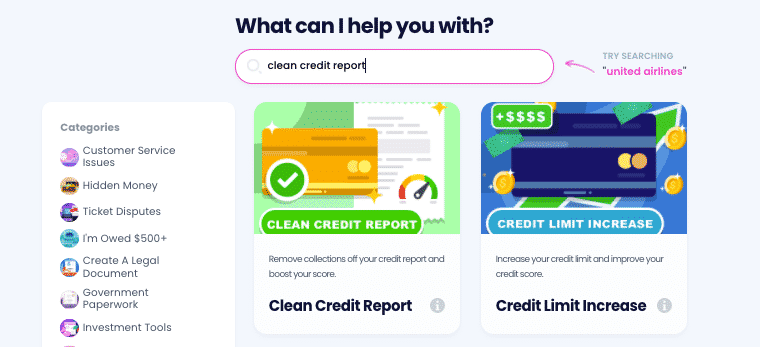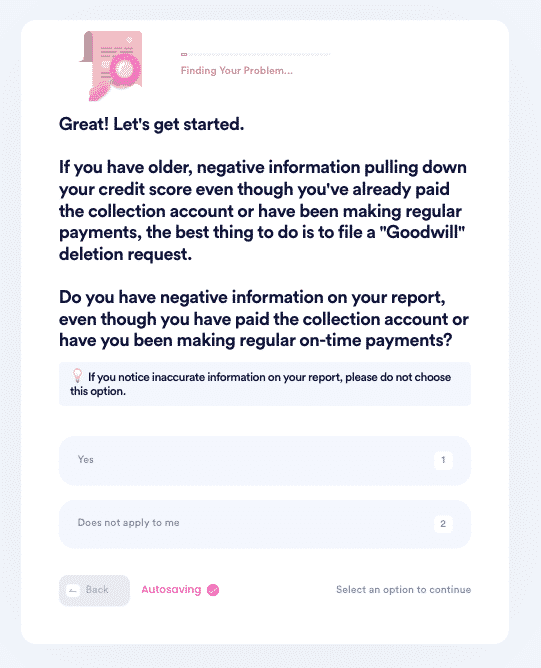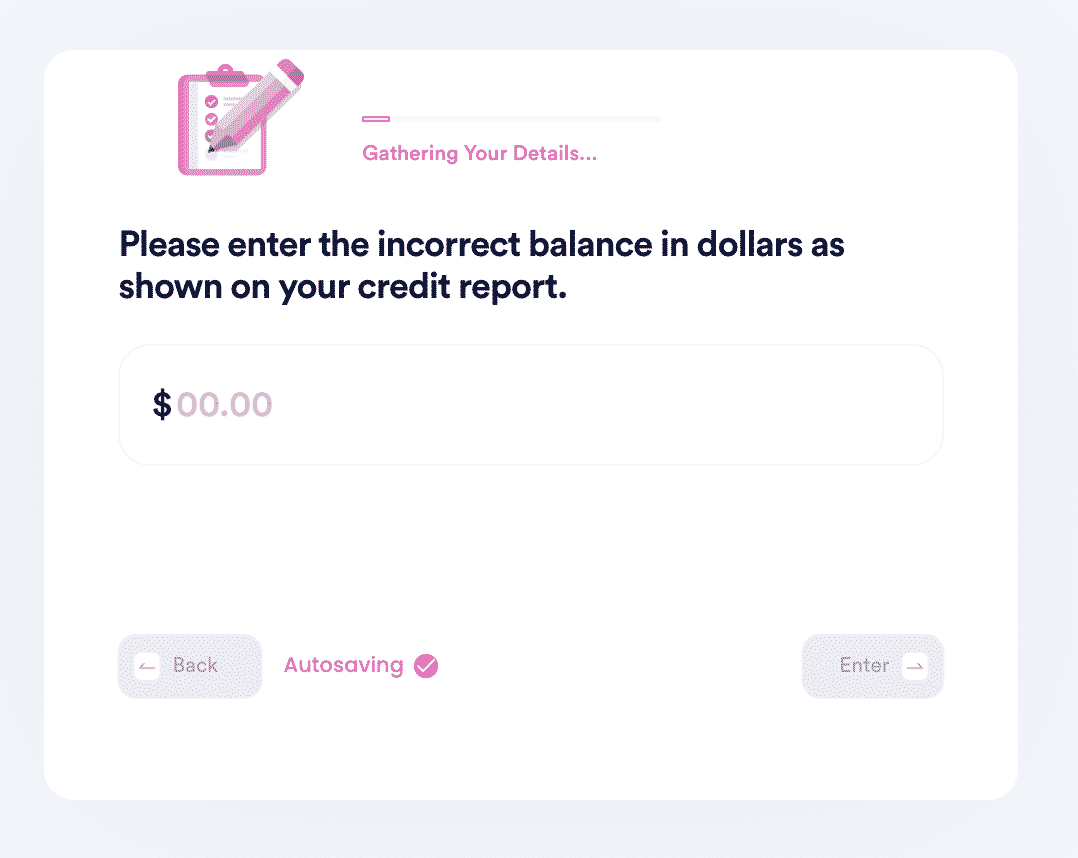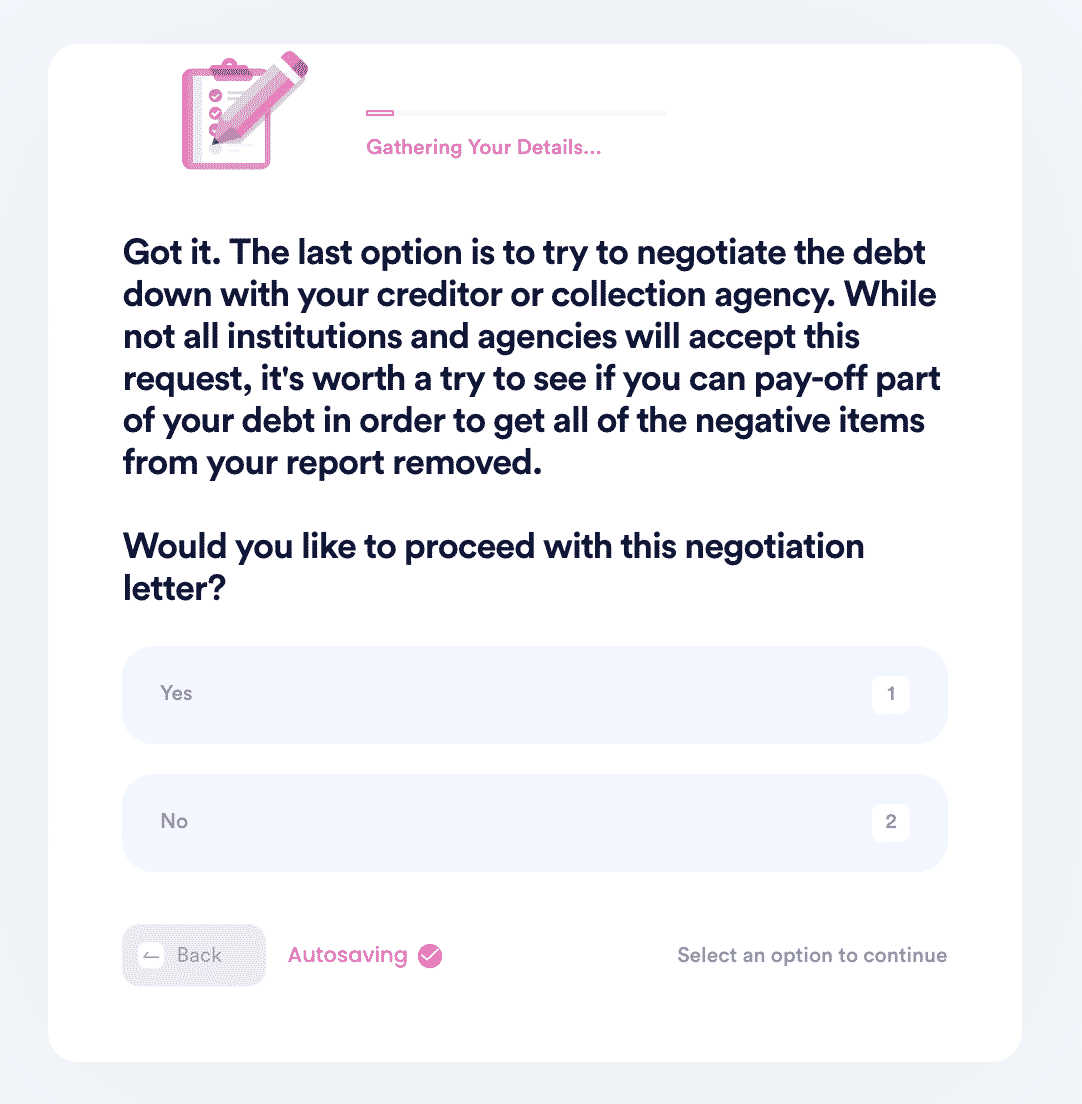Send Out a Goodwill Credit Inquiry Removal Letter with DoNotPay
Are you concerned about your credit score? A poor or low credit rating can mean having difficulty obtaining new credit cards, loans, or medical insurance.
Send a to your creditors to boost your credit score to avoid such repercussions. You might be worried that certain negative marks on your credit report, such as late payments that might turn your debts into collections, are irremovable, but they are removable.
Unfortunately, writing this letter can be challenging, especially if you don't know where to start. That is where DoNotPay comes in to design a removal letter and send it to your creditor for you.
What Is a Goodwill Credit Inquiry Removal Letter?
A goodwill credit inquiry removal letter/forgiveness removal letter is a letter you write to your creditors or collection agencies requesting them to remove a negative mark from your credit report. When written correctly, this letter can boost your credit score by 60 to 110 points.
While sending the letter isn't guaranteed that the negative marks will be removed, it's a chance worth taking. Negative marks stain your credit report for up to 7 years. If there's a chance that the letter can remove them, you better take it. That's why it's wise to have an expert such as DoNotPay write a letter on your behalf.
Gain Deeper Insights into Your Credit Report
Many people aren't aware of what factors contribute to their credit scores, let alone knowing what a credit report is. If you are among this group, you are in the right place.
A credit score is a statistical analysis/numerical value from 300 to 850 on the FICO scale that highlights your creditworthiness, while a credit report is a statement that highlights this credit score. The higher the value, the higher and better the credit score.
Your credit score is determined by:
| Debt payment history | 35% |
| Total level of debts | 30% |
| Repayment history | 15% |
| Types of credit, such as credit cards, mortgages, auto loans, among others | 10% |
| New lines of credit | 10% |
Here is what a credit report contains:
- Personal information
- All your credit accounts and their vital information
- Inquiries. Soft inquiries are self-checks for checking the current parties that constantly check your credit status. A soft inquiry doesn't affect your credit score. A hard inquiry is a check conducted by other parties when you apply for lines of credit. A hard inquiry affects your credit score, albeit for one year, and ding your credit report by up to five points.
- Any collection accounts that have been turned over to collection agencies due to past due dates.
- Any bankruptcies
Remember: creditors, lenders, insurance agencies, property owners, and other businesses use your credit score report to decide whether to extend you a line of credit. Therefore, making regular self-checks ensure your credit info is updated and error-free.
How to Clean Your Credit Score On Your Own
A higher credit score will go a long in ensuring you get approved for loans. You can DIY and clean your credit score by:
- Disputing any errors
- Timely debt repayments
- Make regular credit score reviews
- Minimize credit utilization to 30%
- Handle your outstanding bills
- Request negative mark removal via a removal forgiveness letter
There Is an Error On My Credit Report. Can I Dispute It?
There are instances where your credit report returns some errors, maybe a creditor or collection agency hasn't updated on your repaid debts, or the credit bureaus haven't updated your credit status. In this case, send a credit dispute letter to all credit bureaus and the data furnisher, such as the bank or creditor.
If you decide to dispute the credit report on your own, you can follow these steps:
- From your browser, visit AnnualCreditReport.com and acquire a free annual credit report from all credit reporting companies
- Point out any errors in the credit report in the form of:
- Incorrect personal info
- Erroneous accounts
- Public records such as bankruptcies, foreclosures, and repossessions
- Credit limit and balances errors
- Repeated errors after previous corrections
- Attach the dispute letter to the credit report highlighting the errors, and send them to all credit bureaus via their online portals or by mail, and data furnishers
- If your dispute is genuine, the credit bureaus and data furnisher will conduct a 45-day investigation and furnish you with the findings. However, if the disagreement is frivolous, you'll receive a notice of non-investigation within five days
I'm Unsure a Debt Is Mine. What Can I Do?
If you are unsure of a debt a creditor is asking you to pay, ask them to send you a debt verification letter containing details including:
- The amount you owe
- The creditor's details
- A statement that the creditor deems the debt valid unless you challenge it within 30 days after the first contact
- A notice that the creditor must confirm the debt by mail if you contest the debt in writing within 30 days
- A statement the creditor must provide the original creditor's information within the 30 days
However, if the debt validation letter is unclear, or you need further clarification, you write a debt verification letter to the creditor asking for:
- The original creditor's details
- The amount and age of the balance, including the date of the last repayment
- Reasons why the creditor believes the debt is yours
- The authority to collect the debt
- If the debt's statute of limitation is still valid or not
It's best to ask for the verification letter within 30 days of receiving the debt validation to halt further debt collection advances. If the creditor continues, you can complain to:
If you are worried about writing a debt verification letter yourself, the CFPB has templates you can check out.
Are you prepared to go through all this hassle by DIYing your credit clearance process? Think about all the forms you need to fill, the websites you need to visit, and the complaints you need to lodge with different bodies. Worse still, you have to write different letters! You have to spend valuable time learning how to write these letters. You don't have to go through all that! Just use the best way – DoNotPay.
Your DIY Methods of Cleaning Your Credit Score Have Failed. What Next?
Disputing errors on your credit report on your own might fail, or you might be dissatisfied with the investigation's findings. Additionally, the credit bureaus may not update your credit report even after the investigation unearths an error in your report.
The next step is complaining with the Consumer Financial Protection Bureau via their online complaints portal. Be sure to attach only the dispute you reported to the credit bureaus.
How to Clean Up Your Credit Report Using DoNotPay
If you want to clean up your credit report but don't know where to start, DoNotPay has you covered in 3 easy steps:
- Search Clean Credit Report on DoNotPay.

- Prepare a recent copy of your credit report that you can use as reference.

- Let us guide you through the 4 potential options:
- If you've already paid off your debt, we'll help you file a Goodwill Removal Request to get it removed.

- If you notice any errors in your report (we have a list of common errors you can use!), we'll help you file a credit dispute to the creditor or major credit bureaus.

- If there are no errors, we'll check if you're still eligible to file a debt validation request. If they can't validate your debt, they're required to remove it from your report, and they can't collect it!

- Lastly, if none of the above options work, we'll help you file a pay-to-delete negotiation letter. You can customize the amount you are willing to pay in exchange for getting the item removed.

You can also check out our other credit products, including Credit Limit Increase, Get My Credit Report, Keep Unused Cards Active, and more!
Why Use DoNotPay to Write a Goodwill Credit Inquiry Removal Letter
Keeping in mind the importance of cleaning your credit score, you can't miss using a revolutionary credit cleaning app like DoNotPay. When you do, you will experience:
- Super-fast and convenient processes
- Easy steps
- Highest chances of success
- Reduces time and resources consumption
What Else Can DoNotPay Do?
If you have any other challenges apart from , DoNotPay can help you with them. Our versatile platform can:
- Help you with an assortment of bills
- Guide you on Financial Aid Appeal Letters
- Cancel any service or subscription
 By
By